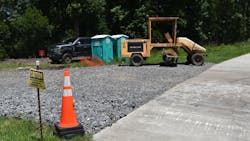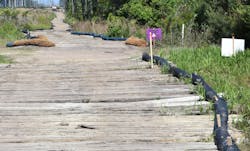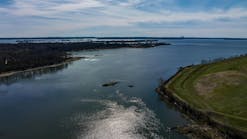Regulatory Compliance as a Design Discipline
Today’s complex construction-related projects often involve multi-jurisdictional permitting, wetland and cultural resource accommodations, cross-disciplinary teams, and environmental compliance inspections. The ability of a project team to design, permit, construct, and reliably conduct self-inspection throughout the lifecycle of the project can often spell the difference between failure and success.
Proper advance planning during the infrastructure design process typically leads to a significant reduction of risk in stormwater compliance when the project reaches the construction phase. With increased federal infrastructure funding due to the American Rescue Plan Act and the Infrastructure Investment and Jobs Act, there will be higher spending in the municipal and infrastructure construction arena, as well as an increased need for shovel-ready projects.
In order to execute more on-time construction projects while maintaining regulatory compliance, it’s becoming more important than ever to have an established, robust, consistent, and highly regarded regulatory compliance program. This is especially true when projects include or are adjacent to sensitive resources like water bodies, wetlands, cultural resources, salt marshes, significant trees, and other valuable community assets.
One way to significantly reduce a risk of noncompliance, while also making more successful projects generally, is to create a mindset that enables the design team to look at a project and its impacts holistically through an environmental regulatory lens. This means considering not only the actual physical assets constructed but also the impacts of construction, including staging, material and equipment storage, stringing pipe, stockpiling excavated materials, parking for construction team members, and maintenance.
As the regulatory community tries to keep pace with an ever-increasing number of projects, it has become even more essential to keep these projects on track. It is critical on several levels for a linear, site, earthwork, or environmentally sensitive project to go through a regulatory review at key milestones to ensure that it can be constructed as the design team has envisioned, with all impacts properly recognized, accounted for, and mitigated. This can be accomplished in multiple ways.
Collaborative Design Reviews
Designing a project to avoid or minimize impacts from the outset is the most effective. The farther into a project timeline that an impact is encountered, the more costly it will be to correct or mitigate. Minor design changes that are recognized when moving a project from conceptual to a 30 percent phase can always help facilitate a more efficient design process. This is the time to add a “Collaborative Review” milestone.
At this point in the design life, it is beneficial to bring in team members with expertise in construction techniques, materials handling, logistics, operations, site work, and regulatory compliance to review and brainstorm collectively. Envisioning the completed construction and operational implementations can significantly improve the project delivery process while also building team confidence and trust.
Lifecycle costs can be significantly lowered as well when operational and maintenance aspects are assigned a high priority during the design process. After all, even though the design and permitting process may take several years to complete, operational terms can take decades.
Having the end user of a project represented throughout the entire planning and construction process creates a feedback loop that will necessarily improve the design.
Effective Communication Plans
Environmental permitting is also an essential process for maintaining environmental and regulatory compliance. As an example, a natural gas transmission main can often traverse multiple county and municipal jurisdictions. Most projects of this type include various terrains, property owners, permitting jurisdictions, and interactions with the public, as well as crossings of other transportation and utility assets and sensitive environments.
The constructability of a project can raise dramatically when the design and construction team self-regulate throughout the project to monitor, maintain, report, and close out. It can also build confidence among the regulatory community and the general public. The designation of roles and responsibilities associated with compliance is essential, as is placing authority with the compliance team members.
In the example of the gas transmission main, the project included multiple wetland crossings, encroachment permits, and easements; each of which had associated special conditions. In addition, each municipal stormwater jurisdiction had special permit conditions to prevent adverse impacts to adjacent resources and water quality.
The project was designed with significant staging areas that allowed ample space for materials, storage, equipment maintenance, office and management, parking, and communication facilities. There were access locations along the route and there were several nearby cultural resources where special care was afforded.
Many special provisions of the various permits were addressed using specific best management practices (BMPs) such as erosion control devices, access facilitation devices, temporary bridges, and signage to designate sensitive areas such as wetlands.
The environmental compliance team, armed with a clear plan in hand, was able to constantly monitor all aspects of the regulatory compliance program through the construction cycle. This enabled effective communication with the range of jurisdictional inspectors and created important trust-based relationships as the project progressed. It also clearly demonstrated the dedication to environmental compliance of the owners, engineers, and contractors.
As is the case with all projects, developing an effective communication plan is essential. In this case, a weekly progress meeting was initiated during the design process that covered all aspects of the project, including permitting and compliance.
Designating the meetings as a specific project category assisted in driving progress while establishing a very close working relationship with the members of the environmental compliance team who ultimately became responsible for implementing and enforcing the project plans and requirements as the project transitioned to construction.
That transition was a specific point in time marked by an environmental permit transition conference. This conference included the actual personnel responsible for installing, monitoring, and reporting all aspects related to environmental compliance. Each member of the team was able to learn their exact roles, which helped them coalesce and become an effective unit. As the project progressed, any challenges that arose during construction were quickly and effectively addressed in a collaborative manner, enabling completion with no anomalies associated with environmental permitting.
This practice of engaging the environmental compliance team members early and throughout the design process clearly served to reduce risk, resulting in a project that was completed with none of the delays or cost increases created by regulatory compliance challenges.
Clearly, permitting and compliance can and should be incorporated with a high level of importance early in the design process in order to save time, gain regulatory trust, and to help prevent additional costs during construction. SW
Robert Horner, P.E., is a vice president and regional manager for Weston & Sampson. He has over 30 years of experience that includes stormwater management, water and wastewater system rehabilitation, water transmission and distribution, roads, bridges, and drainage.
Jeannie Lewis is a senior project manager with Weston & Sampson, holding more than 30 years of experience in coastal regulatory permitting and compliance, stormwater management, environmental policy, wildlife and water quality protection strategies, and habitat restoration.
Emmett Smith, E.I.T., is a civil engineer with Weston & Sampson. His experience includes site development associated with linear utility replacement and installation.
Published in Stormwater magazine, February 2022.
Emmett Smith
Emmett Smith, EIT, is a civil engineer with Weston & Sampson. His experience includes site development associated with linear utility replacement and installation.
Jeannie Lewis
Jeannie Lewis is a senior project manager with Weston & Sampson, holding more than 30 years of experience in coastal regulatory permitting and compliance, stormwater management, environmental policy, wildlife and water quality protection strategies, and habitat restoration.
Robert Horner
Robert Horner, PE, is a vice president and regional manager for Weston & Sampson. He has over 30 years of experience that includes stormwater management, water and wastewater system rehabilitation, water transmission and distribution, roads, bridges, and drainage.









